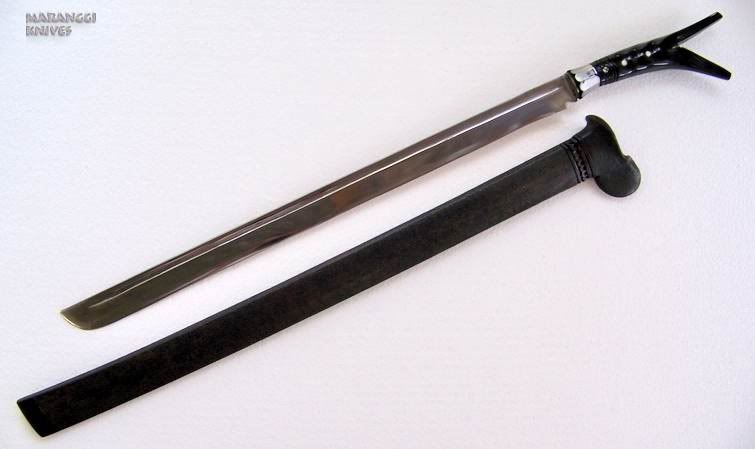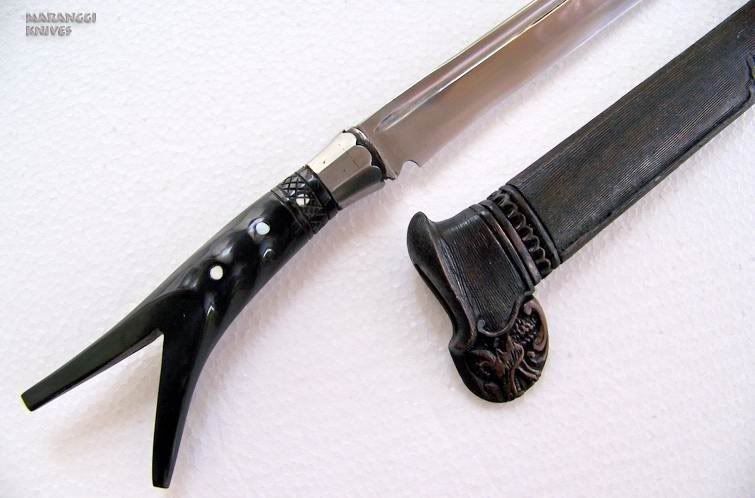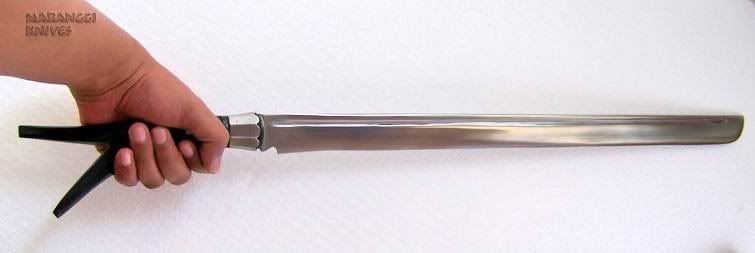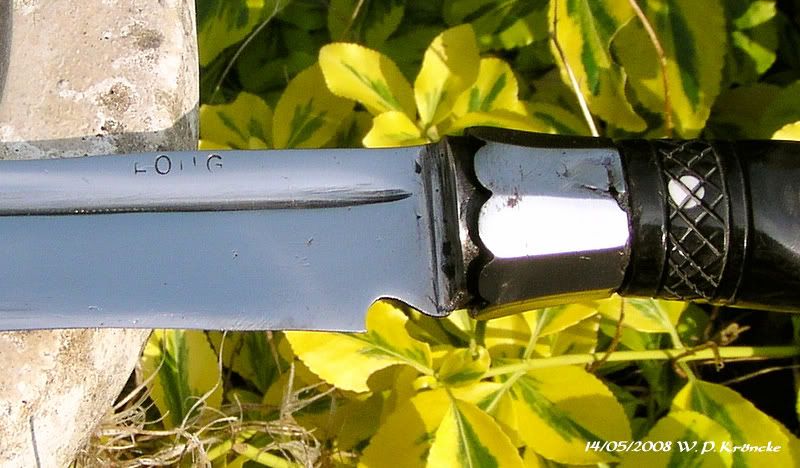
 |
|
|
|
|
#1 |
|
Member
Join Date: Mar 2006
Location: Room 101, Glos. UK
Posts: 4,170
|
hi y'all, thought i'd share this one with you. it decided it wanted to come live with me.
traditional acehnese sikin pedang,  overall view  grip/scabbard throat  in-hand view, noviar's (see below) hand, not mine, yet. made by a village blacksmith in northern aceh province, indonesia, sold by a dealer just west of jakarta who is supporting the knifesmiths of the area which was devastated in the 2005 tsunami, as well as smiths in java. Item Description: Condition : New Weight : +/- 800 gram Material : Handle & Sheath = Buffalo Horn, Mentru Wood Blade = Spring Steel Overall Length : +/- 29" / 83 cm Blade Length : +/- 21.5" / 54 cm Handle Length : +/- 7.25" / 18.5 cm - Its a new piece with wooden sheath, satin finish, sharp edge, and fully functional. - The sheath is made of Mentru Wood, with simple ornament and stripes. Naga relief carving was added to the sheath near handle. - The handle is made of solid black water buffalo horn. - The handle bolster is made of carbon steel. This bolster has a flaw, i.e. a deep split of forging. - This sikin is made by a native Acehnese blacksmith in North Aceh. more pics when it arrives. the seller, noviar at maranggi knives is a computer programmer/systems developer & practices silat as well as selling these knives and swords...his email bill message started off with 'thanks for trusting me'. thanks for selling, noviar! nice to see that these are still being made by traditional craftsman. Last edited by kronckew; 7th May 2008 at 09:04 AM. |
|
|

|
|
|
#2 |
|
Member
Join Date: Nov 2006
Location: The Netherlands
Posts: 2,224
|
And thanks for making them straight and not curved.
 Nice piece by the way. |
|
|

|
|
|
#3 | |
|
Member
Join Date: Mar 2006
Location: Room 101, Glos. UK
Posts: 4,170
|
Quote:
|
|
|
|

|
|
|
#4 |
|
Member
Join Date: Mar 2006
Location: Room 101, Glos. UK
Posts: 4,170
|
well it arrived yesterday, he sent it EMS as a 'gift' tho i only paid for std. mail.
the wood scabbard is carved all over with a fine set of parallel lines, with decorative panels every 6 in. the throat protrusion and the area just above the polished black horn chape are also decoratively carved. the back only has the parallel lines except for a decorative band around the throat which goes right around. the grip is polished horn, there are three inlaid white circles on either side which may cover rivets thru the tang. the sides of the grip are rippled-like smooth finger grooves, highly polished. the open 'mouth of the alligator' has been left fairly rough inside, not polished and showing sanding grooves tho it feels smooth to the touch. there are two holes, one that appear to have been a void in the horn, the other looks like a slot for the tang, its filled with what appears to be sumatran cutlers cement, what some of us would call 'laha'. i'll probably fill them level with plastic steel & polish them a bit more. the end of the horn next to the bolster is carved somewhat crudely with checkering which is also over the 1st set of white inlays. the octagonal scalloped bolster has a small forging flaw on one side, apparent in the photo below. the 54cm. (21.25in.) blade itself is well balanced, feels good in the hand, starts out with a flat spine and changes to a V spine after about 76mm. (3 in.), blade is distally tapered, 5mm at guard, 3mm at the tip end of the fuller, 32mm wide blade, has a forged fuller either side almost to the tip, and has a steel guard disk slightly smaller in dia. than the scalloped end of the bolster, this appears to have been formed with or welded to the blade, then machined or filed flat (hopefully added before the final heat treatments). about 3mm (1/8 in.) sticks out ahead of the bolster, the rest appears to taper into and then under the bolster scallops for an unknown distance, tho the indications are it's at least 3/8" thick... there is a stamp on the blade spine that looks like 'LO G' and the remains of a 4th letter which may be an N, H or M in between. i'll have to ask the vendor. blade is wickedly sharp, convex edged. now the pics.    the dark 'stain' on the blade just under the sundial's gnomen is actually the reflection of my head. 
|
|
|

|
|
|
#5 | |
|
Member
Join Date: Apr 2007
Location: Nothern Mexico
Posts: 458
|
Quote:
My regards Gonzalo |
|
|
|

|
|
|
#6 |
|
Member
Join Date: Mar 2006
Location: Room 101, Glos. UK
Posts: 4,170
|
if it was forge welded together at the same time the blade was made, it is essentially 'integral' to the blade. that would be the best. silver soldering or other low temp. soldering would also be OK.
i have heard of some less particular 'smiths' electrically welding tangs, or extensions or even wood screws to blades afterwards, which would possibly ruin any heat treatment, and weaken the join. it at least would present a discontinuity in the chemical composition of the metal where the welding rod metal was deposited... i've also seen welded steel ships that had had great care and inspection during construction crack under stress along the weld joints. i do not see any signs that any modern welding has taken place on this blade tho. it appears to have been entirely hand forged. final finishing probably had an assist from power tools tho, which is also OK, otherwise it would cost a lot more.. and, yes, laha to me is himalayan epoxy  tree resin, dung, brick dust, and other admixtures the kami's add to the recipe. tree resin, dung, brick dust, and other admixtures the kami's add to the recipe.the inverted 'v' shape starts towards the tip from the stamped lettering forward, possibly to lighten the blade and improve the balance, it's also a bit more decorative. from above the stamped letters back to the guard it is flat. interestingly, the blade thickness swells (increases) by an additional 4mm. over about the last 4mm. forming a shoulder that the guard sets on. this joint then appears to have been hand filed and finished after welding. i see a similar flat spine transition to round or inverted V on some of my Dha's tho on those the flat extends for almost a third of the blade and is decorated with inlays. Last edited by kronckew; 16th May 2008 at 11:59 AM. |
|
|

|
 |
|
|